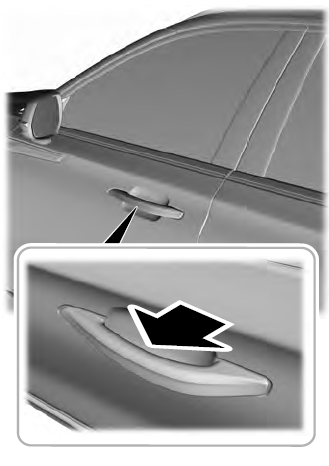Lincoln Aviator: Tire Pressure Monitoring System (TPMS) / Removal and Installation - Tire Pressure Monitoring System (TPMS) Sensor
Removal
-
.jpg) WARNING:
The Tire Pressure Monitoring System (TPMS) sensor
battery may release hazardous chemicals if exposed to extreme mechanical
damage. If these chemicals contact the skin or eyes, flush immediately
with water for a minimum of 15 minutes and get prompt medical attention.
If any part of the battery is swallowed, contact a physician
immediately. When disposing of Tire Pressure Monitoring System (TPMS)
sensors, follow the correct procedures for hazardous material disposal.
Failure to follow these instructions may result in serious personal
injury.
WARNING:
The Tire Pressure Monitoring System (TPMS) sensor
battery may release hazardous chemicals if exposed to extreme mechanical
damage. If these chemicals contact the skin or eyes, flush immediately
with water for a minimum of 15 minutes and get prompt medical attention.
If any part of the battery is swallowed, contact a physician
immediately. When disposing of Tire Pressure Monitoring System (TPMS)
sensors, follow the correct procedures for hazardous material disposal.
Failure to follow these instructions may result in serious personal
injury.
NOTE: The Tire Pressure Monitoring System (TPMS) sensor cannot be removed without disassembly of the wheel and tire.
Disassemble the wheel and tire.
Refer to: Wheel and Tire (204-04A Wheels and Tires, Disassembly and Assembly).
Installation
-
NOTE: The Tire Pressure Monitoring System (TPMS) sensor cannot be installed without disassembly of the wheel and tire.
Assemble the wheel and tire.
Refer to: Wheel and Tire (204-04A Wheels and Tires, Disassembly and Assembly).
 General Procedures - Tire Pressure Monitoring System (TPMS) Sensor Location Calibration
General Procedures - Tire Pressure Monitoring System (TPMS) Sensor Location Calibration
Special Tool(s) /
General Equipment
204-D081A
(204-D081)
Tire Pressure Monitor (TPMS)
Ford Diagnostic Equipment
Programming
NOTE:
The TPMS can be placed into learn mode using a diagnostic scan tool or manually where a diagnostic scan tool is not available...
Other information:
Lincoln Aviator 2020-2025 Service Manual: Diagnosis and Testing - Universal Transmitter
Symptom Chart(s) Symptom Chart: Universal Home Transmitter Diagnostics in this manual assume a certain skill level and knowledge of Ford-specific diagnostic practices. REFER to: Diagnostic Methods (100-00 General Information, Description and Operation)...
Lincoln Aviator 2020-2025 Service Manual: Removal and Installation - Turbine Shaft Speed (TSS) Sensor
Removal Remove the main control valve body. Refer to: Main Control Valve Body (307-01A Automatic Transmission - 10-Speed Automatic Transmission – 10R60, Removal and Installation). Remove the TSS sensor. Slide the plastic lock to the unlocked position...
Categories
- Manuals Home
- Lincoln Aviator Owners Manual
- Lincoln Aviator Service Manual
- Configuring The Head Up Display
- Tire Change Procedure
- Body and Paint
- New on site
- Most important about car
Activating Intelligent Access
The intelligent access key must be within 3 ft (1 m) of the door or luggage compartment you intend to lock or unlock.
At a Door
Electronic door handles are on each door. Gently depress the switch inside the exterior door handle to unlock and open the door. An unlock symbol illuminates on the door window trim indicating your vehicle is unlocked.


